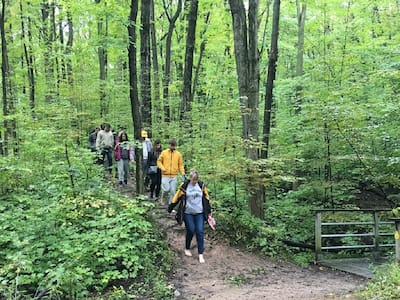
Spending time in nature can improve heart rate variability, a marker of autonomic nervous system balance associated with overall health.
Connecting with nature is one of the best ways of alleviating pain and stress of any kind. Nature does have power to bring a huge change in a person. That is the reason why natural therapies are given so much importance. Research has shown the health benefits of exposure yo nature and green environments. Here we are going to look at something very similar to natural therapies and it is called forest bathing or Shinrin-Yoku.
What is this practice?
Forest bathing that is also known as Shinrin-Yoku in Japanese involves immersing and imbuing oneself in a natural forest environment while also engaging in its surroundings. This kind of practice have some health benefits connected to it including stress reduction, immune system enchantment and improved mental well being.
Forest bathing is not any kind of physical exercise and it isn’t about achieving specific goals, instead it is about being present in nature, using all of your senses to connect with your surroundings. Connecting with a nature is a profound process. Practitioners often engage in activities like walking, sitting, and observing in the forest environment, paying attention to the sounds, sights, smells, and textures around them. Mindfulness and deep breathing are other activities that are commonly incorporated into the practice, helping individuals reduce stress and promote relaxation.
Let’s look at some benefits of forest bathing practice!
Helps In Reducing Stress
Spending time in a natural forest setting can have a calming effect on the nervous system. It helps your mind to relax and enjoy the sights, sounds, and scents of the forest for attaining a state of relaxation.
Boosting the Immune System
Some studies suggest that exposure to phytoncides, natural compounds produced by trees and plants, can enhance the activity of natural killer (NK) cells, a type of immune cell that targets viruses and cancer cells. This can lead to temporary improvements in immune function.
Helps In Improving Mental Well-Being
Forest bathing has been associated with reduced symptoms of anxiety, depression, and other mood disorders. The sensory experience of being in nature can have a positive impact on mood and emotional well-being.
There Are Cognitive Benefits Too
Forest bathing may enhance cognitive function, attention, and creativity. Time spent in nature can provide a mental break from the demands of modern life, allowing the mind to recharge.
Blood Pressure Regulation
Exposure to nature and the practice of forest bathing have been linked to lowered blood pressure, which is beneficial for cardiovascular health.
READ RELATED: 6 Best-Tasting New Salad Dressings You Should Try Right Now
Positive Impact on Heart Rate Variability
Spending time in nature can improve heart rate variability, a marker of autonomic nervous system balance associated with overall health.
Reduced Negative Thinking
Rumination, repetitive negative thinking, is common in stress and depression. Forest bathing has been shown to reduce rumination, promoting a more positive mental state.
Enhanced Relaxation
The sights and sounds of the forest environment can induce a state of relaxation and tranquility, helping individuals disconnect from daily stresses.
Connection with Nature
Forest bathing encourages a deeper connection with the natural world, fostering a sense of awe and appreciation for the environment.
Forest Bathing is known to provide therapeutic experiences like any other form of natural therapies. But incorporating forest bathing into a broader self-care routine may contribute to overall well-being, especially for those who enjoy spending time in nature.
Total Wellness is now just a click away.
Follow us on
Don’t Miss Out on the Latest Updates.
Subscribe to Our Newsletter Today!
window.addEventListener(‘load’, (event) => {
$(‘#commentbtn’).on(“click”,function(){
(function(d, s, id) { var js, fjs = d.getElementsByTagName(s)[0]; if (d.getElementById(id)) return; js = d.createElement(s); js.id = id; js.src = “//connect.facebook.net/en_US/sdk.js#xfbml=1&version=v2.3”; fjs.parentNode.insertBefore(js, fjs);}(document, ‘script’, ‘facebook-jssdk’));
$(“.cmntbox”).toggle();
});
});








